
Concept explainers
(a)
Interpretation: The relationship between ![]() and
and ![]() is to be stated.
is to be stated.
Concept introduction: The anomers are cyclic monosaccharides, which differ in configuration at one stereogenic centre. These carbon atoms are called anomeric centre.
Answer to Problem 28.42P
The compounds ![]() and
and ![]() are epimers.
are epimers.
Explanation of Solution
The structures of compounds ![]() and
and ![]() are,
are,
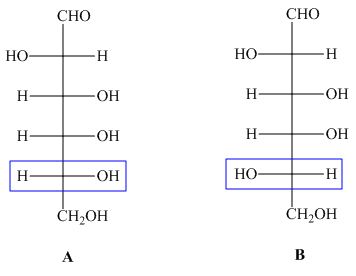
Figure 1
In the given structures, the configuration at ![]() is different. Hence, the compounds
is different. Hence, the compounds ![]() and
and ![]() are epimers.
are epimers.
The compounds ![]() and
and ![]() are epimers.
are epimers.
(b)
Interpretation: The relationship between ![]() and
and ![]() is to be stated.
is to be stated.
Concept introduction: The anomers are cyclic monosaccharides, which differ in configuration at one stereogenic centre. These carbon atoms are called anomeric centre. The compounds which are neither mirror images nor supperimposable on each other are known as diastereomer.
Answer to Problem 28.42P
The compound ![]() and
and ![]() are diastreomers but not epimers.
are diastreomers but not epimers.
Explanation of Solution
The structures of given compound ![]() and
and ![]() are,
are,
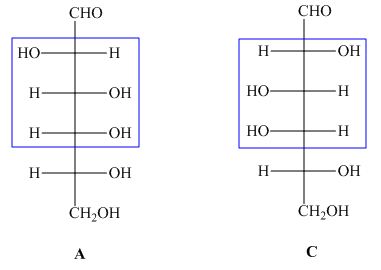
Figure 2
In the given structures, the compound ![]() is not mirror image of compound
is not mirror image of compound ![]() and the configuration of more than is different. Hence, the compound
and the configuration of more than is different. Hence, the compound ![]() and
and ![]() are diastreomers but not epimers.
are diastreomers but not epimers.
The compound ![]() and
and ![]() are diastreomers but not epimers.
are diastreomers but not epimers.
(c)
Interpretation: The relationship between ![]() and
and ![]() is to be stated.
is to be stated.
Concept introduction: The compounds which are mirror images as well as non-supperimposable on each other. These compounds are known as enantiomers.
Answer to Problem 28.42P
The compound ![]() and
and ![]() are enantiomers.
are enantiomers.
Explanation of Solution
The structures of given compound ![]() and
and ![]() are,
are,
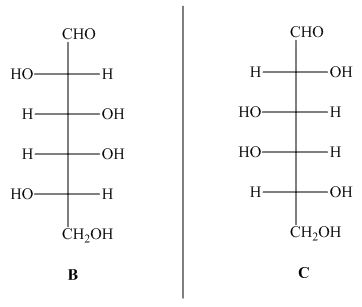
Figure 3
In the given structures, the compound ![]() is mirror image of compound
is mirror image of compound ![]() . Hence, the compound
. Hence, the compound ![]() and
and ![]() are enantiomers.
are enantiomers.
The compound ![]() and
and ![]() are enantiomers.
are enantiomers.
(d)
Interpretation: The relationship between ![]() and
and ![]() is to be stated.
is to be stated.
Concept introduction: The compounds which have same molecular formula but differ in connectivity of the substituents. These compounds are known as constitutional isomers.
Answer to Problem 28.42P
The compound ![]() and
and ![]() are constitutional isomers.
are constitutional isomers.
Explanation of Solution
The structures of given compound ![]() and
and ![]() are,
are,
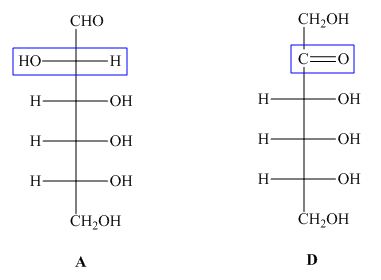
Figure 4
In the given structures, the molecular formula of ![]() is same to the molecular formula of
is same to the molecular formula of ![]() but the connectivity of substituents at
but the connectivity of substituents at ![]() is different. Hence, the compound
is different. Hence, the compound ![]() and
and ![]() are constitutional isomers.
are constitutional isomers.
The compound ![]() and
and ![]() are constitutional isomers.
are constitutional isomers.
(e)
Interpretation: The relationship between ![]() and
and ![]() is to be stated.
is to be stated.
Concept introduction: The anomers are cyclic monosaccharides, which differ in configuration at one stereogenic centre. These carbon atoms are called anomeric centre. The compounds which are neither mirror images nor supperimposable on each other are known as diastereomer.
Answer to Problem 28.42P
The compounds ![]() and
and ![]() are diastreomers but not epimers.
are diastreomers but not epimers.
Explanation of Solution
The substituents on a carbon are present above the ring in Haworth projection indicates that these bonds are above the plane (i.e. either equatorial or axial position) in chair form. The structures of given compound ![]() and
and ![]() are,
are,
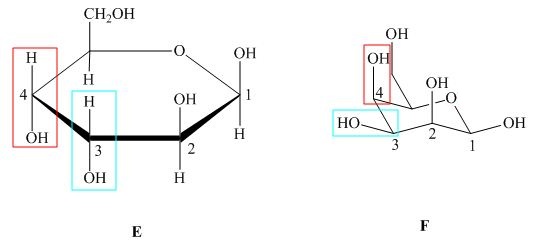
Figure 5
In the given structures, the configuration at ![]() is different which shows that the compound
is different which shows that the compound ![]() is not mirror image of compound
is not mirror image of compound ![]() and. Hence, the compound
and. Hence, the compound ![]() and
and ![]() are diastreomers but not epimers.
are diastreomers but not epimers.
The compounds ![]() and
and ![]() are diastreomers but not epimers.
are diastreomers but not epimers.
Want to see more full solutions like this?
Chapter 28 Solutions
Organic Chemistry
- Label compounds B–D as stereoisomers, conformations, or constitutional isomers of Aarrow_forwardHow is compound A related to compounds B–E? Choose from enantiomers, diastereomers, constitutional isomers, or identical molecules.arrow_forwardClassify each compound as identical to A or its enantiomer.arrow_forward
- Consider the ball-and-stick model of D, and label E and F as either identical to D or an enantiomer of Darrow_forward1) Are the molecules A and B... conformational isomers? Diastereomers? Enantiomers? Position isomers? Non-related? 2) What about the molecules B and C? 3) What about the molecules C and D?arrow_forwardAnswer the following question about compounds A–D (See in attachment) How are the compounds in each pair related? Choose fromconstitutional isomers, stereoisomers, or identical molecules: A and B; A and C; B and D.arrow_forward
- Consider the ball-and-stick models A–D. How is each pair of compounds related: (a) A and B; (b) A and C; (c) A and D; (d) C and D? Choose from identical molecules, enantiomers, or diastereomers.arrow_forwardWhich compounds (B–F) are identical to A? (b) Which compounds (B–F) represent an isomer of A?arrow_forwardDrawn are four isomeric dimethylcyclopropane. a. How are the compounds in each pair related (enantiomers, diastereomers,constitutional isomers): A and B; A and C; B and C; C and D?b. Label each compound as chiral or achiral.c. Which compounds, alone, would be optically active?d. Which compounds have a plane of symmetry?e. Which of the compounds are meso compounds?f. Would an equal mixture of compounds C and D be optically active? Whatabout an equal mixture of B and C?g. How many stereogenic centers are there for each compound?arrow_forward
- Stereoisomers differ from each other in what respect? A.) Composition B.) Constitution C.) Configuration D.) Steric hindrance E.) Nonearrow_forwardDrawn are four isomeric dimethylcyclopropanes. a.How are the compounds in each pair related (enantiomers, diastereomers, constitutional isomers): A and B; A and C; B and C; C and D? b.Label each compound as chiral or achiral. c.Which compounds alone would be optically active? d.Which compounds have a plane of symmetry? e.How do the boiling points of the compounds in each pair compare: A and B; B and C; C and D? f.Which of the compounds are meso compounds? g.Would an equal mixture of compounds C and D be optically active? What about an equal mixture of B and C?arrow_forwarda. Which of these two can exist as a pair of enantiomers?b. Draw the pair of enantiomers using three-dimensional representation.arrow_forward
 Organic Chemistry: A Guided InquiryChemistryISBN:9780618974122Author:Andrei StraumanisPublisher:Cengage Learning
Organic Chemistry: A Guided InquiryChemistryISBN:9780618974122Author:Andrei StraumanisPublisher:Cengage Learning Chemistry for Today: General, Organic, and Bioche...ChemistryISBN:9781305960060Author:Spencer L. Seager, Michael R. Slabaugh, Maren S. HansenPublisher:Cengage Learning
Chemistry for Today: General, Organic, and Bioche...ChemistryISBN:9781305960060Author:Spencer L. Seager, Michael R. Slabaugh, Maren S. HansenPublisher:Cengage Learning

